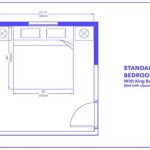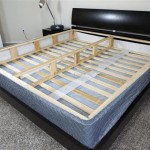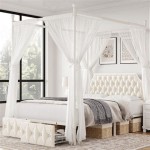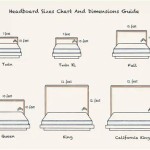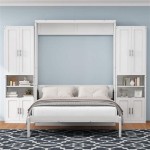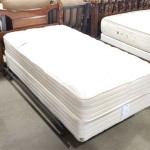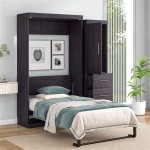What Is The Size Of A Full Bed In Feet?
Understanding the dimensions of a full-size bed, often referred to as a double bed, is crucial when planning a bedroom layout, selecting appropriate bedding, and ensuring comfort for the sleeper. The size of a full bed is standardized, but slight variations may occur depending on the manufacturer. It is essential to know the standard dimensions in feet to make informed decisions about purchasing a bed frame, mattress, and coordinating bedroom furniture.
The standard dimensions of a full-size bed are approximately 54 inches wide and 75 inches long. Converting these measurements to feet, a full bed is 4.5 feet wide (54 inches / 12 inches per foot) and 6.25 feet long (75 inches / 12 inches per foot). These measurements represent the sleeping surface of the mattress and do not include the dimensions of the bed frame, which can add several inches to the overall footprint of the bed.
Knowing the precise measurements in feet allows for accurate space planning within a bedroom. This is particularly important for smaller rooms where maximizing space is a priority. A full bed provides more sleeping space than a twin bed but less than a queen or king-size bed. This makes it a suitable option for single sleepers who desire more room to stretch out or for couples in smaller living spaces.
Understanding the Full Bed Size in the Context of Room Size
When determining if a full bed is suitable for a particular bedroom, it's not just about the dimensions of the bed itself. The overall room size and layout must be considered. To comfortably accommodate a full bed, the room should ideally be at least 10 feet by 10 feet. This allows for sufficient space to walk around the bed, place bedside tables, and incorporate other essential bedroom furniture such as a dresser or wardrobe.
In a smaller room, for example, an 8 foot by 8 foot space, a full bed might feel cramped, leaving limited room for movement and other furniture. It's important to factor in the clearance around the bed – a minimum of two feet on each side is recommended to allow for easy access and comfortable movement. Neglecting this aspect can lead to a cluttered and functionally inadequate bedroom environment.
Ultimately, assessing the room's dimensions and visualizing the placement of the full bed and other furniture is crucial before making a purchase. Using masking tape to mark the outline of the bed on the floor can be a helpful technique for gauging the space and ensuring a comfortable fit.
Full Bed vs. Other Bed Sizes: A Comparative Analysis
Understanding the size differences between a full bed and other bed sizes – twin, queen, and king – is essential for making an informed decision based on individual needs and space constraints. The most common alternative to a full bed is the twin bed, which measures approximately 38 inches wide and 75 inches long (3.17 feet wide and 6.25 feet long). A twin bed is significantly narrower than a full bed, making it suitable for children, teenagers, or single adults in smaller rooms. However, it might not provide enough space for adults who prefer to stretch out or for couples.
Moving up in size, the queen bed represents a significant increase in sleeping area. Queen beds typically measure 60 inches wide and 80 inches long (5 feet wide and 6.67 feet long). This extra width and length make queen beds a popular choice for couples or single individuals who desire ample space. A queen bed occupies a larger footprint than a full bed, requiring a larger bedroom to accommodate it comfortably.
The king bed is the largest standard bed size, measuring approximately 76 inches wide and 80 inches long (6.33 feet wide and 6.67 feet long). King beds provide maximum sleeping space and are ideal for couples who value individual space or have children or pets who may occasionally share the bed. However, a king bed necessitates a large bedroom and may not be suitable for smaller homes or apartments.
Therefore, when choosing between a full bed and other bed sizes, consider the following factors: the number of sleepers, individual sleeping preferences (e.g., the need for ample space to stretch out), the size of the bedroom, and the overall budget. While a larger bed offers more space, it also requires a larger room and typically comes with a higher price tag.
Factors Affecting the Perceived Size of a Full Bed
While the standard dimensions of a full bed are generally consistent, several factors can influence the way its size is perceived within a bedroom. These factors include the bed frame design, the height of the mattress, the color of the bedding, and the surrounding furniture.
The bed frame can significantly impact the perceived size of the bed. A bulky bed frame with a large headboard and footboard will visually occupy more space than a minimalist platform bed frame. Similarly, a high bed frame can make the bed appear more imposing, while a low-profile bed frame can create a more open and airy feel in the room.
The height of the mattress also plays a role in the perceived size of the bed. A thicker mattress will make the bed appear taller and more substantial, while a thinner mattress will result in a lower profile. The color and pattern of the bedding can also affect how the bed is perceived. Light-colored bedding can make the bed appear larger and more inviting, while dark-colored bedding can make it appear smaller and more subdued.
The arrangement and style of the surrounding furniture can influence how the bed is perceived within the room. Clutter and poorly arranged furniture can make the room feel cramped and visually diminish the size of the bed. Conversely, strategically placed mirrors, ample lighting, and minimalist furniture can create a sense of spaciousness and enhance the overall aesthetic appeal of the room.
Therefore, when planning a bedroom design, it's important to consider not only the physical dimensions of the full bed but also the factors that can influence its perceived size. By carefully selecting a bed frame, mattress, bedding, and furniture that complement the room's dimensions and individual preferences, it is possible to create a comfortable and visually appealing bedroom environment.
In addition to the physical aspects of the bed itself, the type of mattress used can influence the overall comfort and usability of the full-size bed. Different mattress types, such as memory foam, innerspring, hybrid, and latex, offer varying levels of support, conformability, and temperature regulation. These factors can affect the quality of sleep and the overall satisfaction with the bed.
Memory foam mattresses are known for their ability to conform to the shape of the body, providing pressure relief and support. Innerspring mattresses, on the other hand, offer a more traditional feel with a bouncy surface. Hybrid mattresses combine the features of memory foam and innerspring mattresses, providing a balance of comfort and support. Latex mattresses are known for their durability and natural breathability, making them a good option for individuals who tend to sleep hot.
The choice of mattress should be based on individual sleeping preferences, body weight, and any specific health considerations, such as back pain or allergies. Testing out different mattress types in a store or reading online reviews can help in making an informed decision. Furthermore, it's important to consider the mattress's thickness or height, as this can affect the overall height of the bed and its visual impact on the room.
Beyond the core components of the bed and mattress, the selection of appropriate bedding is crucial for enhancing comfort and creating a cohesive aesthetic. The type of sheets, blankets, and pillows used can significantly impact the sleeping experience and the overall look and feel of the bedroom.
Sheets are available in a variety of materials, including cotton, linen, silk, and microfiber. Cotton sheets are a popular choice due to their breathability, durability, and affordability. Linen sheets are known for their luxurious feel and ability to wick away moisture. Silk sheets are exceptionally soft and smooth but require more delicate care. Microfiber sheets are affordable and resistant to wrinkles and stains.
The choice of blankets should be based on the climate and individual preferences. Down comforters offer excellent warmth and insulation, while lightweight quilts are suitable for warmer temperatures. Weighted blankets have gained popularity for their ability to promote relaxation and reduce anxiety.
Pillows are essential for providing proper neck and head support during sleep. Different types of pillows, such as memory foam, down, feather, and latex, offer varying levels of firmness and support. The ideal pillow should align the spine and prevent neck strain.
In conclusion, understanding the dimensions of a full-size bed in feet is crucial for effective space planning, selecting appropriate bedding, and ensuring a comfortable sleeping environment. By considering the room size, comparing bed sizes, accounting for factors affecting perceived size, and choosing appropriate bedding and mattresses, individuals can effectively select a suitable bed for their needs and create a functional and aesthetically pleasing bedroom.

Mattress Sizes And Dimensions Guide

Bed Sheet Sizes And Dimensions Guide Dreamcloud

Bed Sizes Uk Beds Dimensions Guide Bedhut

King Size Bed Dimensions In Feet Google Search

Bed Sizes Why Would You Need A 9 Foot Well I M Glad Asked Have Dogs And Husband Who Sleeps In The Middle It Be Perfect For

Twin Vs Full Mattress Comparing Dimensions Cost More

Headboard Sizes Chart And Dimensions Guide Dreamcloud

Double Mattress Size Standard Dimensions

Full Vs Double Bed What S The Difference Sleep Authority

King Vs Queen Size Beds Differences Comparison And Benefits

